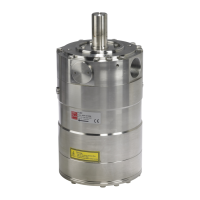180R9346 | AQ240486503020en-001702 | 31© Danfoss | 2023.03
Operation guide Installation, Operation and Maintenance APP 53-92 pumps
9.1 Filtration
Proper ltration is crucial for the performance,
maintenance and warranty of your pump.
Protect your pump, and the application in which
it is installed, by always ensuring that all ltration
specications are met, and by always changing
lter cartridges according to schedule.
Since water has very low vicosity, Danfoss APP
pumps have been designed with very narrow
clearances in order to control internal leakage
rates and improve component performance.
To minimize wear on the pump, it is therefore
essential to lter inlet water properly.
The main lter must have a ltration eciency of
99.98% at 10 m. We strongly recommend that
you always use precision depth lter cartridges
rated 10m abs. ß
10
≥5000.
Please note that we do not recommend bag
lters or string-wound lter cartridges, which
typically have only 50% ltration eciency. This
means that out of the 100,000 particles that enter
such lters, 50,000 particles pass right through;
compare this to precision depth lters that are
99.98% ecient, and only allow 20 of the same
100,000 particles to pass through.
For more information on the importance of
proper ltration, including explanation of
ltration principles, denitions and guidance on
how to select the right lter for your pump,
please consult our Filtration information and
specications (Danfoss document number
521B1009).
Noise
Since the pump unit is typical mounted on a
frame or bell housing the overall noise level can
only be determined for a complete system. To
minimize vibrations and noise throughout the
system, it is therefore very important to mount
the pump unit correctly on a frame with
anti-vibration-dampeners, and to use exible
hoses rather than metal pipes where possible.
The noise level is inuenced by:
• Pump speed:
High rpm generates more uid/structure
borne pulsations/vibrations than low rpm,
because of higher frequency.
• Discharge pressure:
High pressure generates more noise than
low pressure.
• Pump mounting:
Rigid mounting generates more noise than
exible mounting, because of structure-
borne vibrations. Be sure to use dampeners
when mounting.
• Connections to pump:
Pipes connected directly to the pump make
more noise than exible hoses, because of
structure-borne vibrations.
• Variable frequency drives (VFD):
Motors regulated by VFDs can produce
more noise if the VFD does not have the
right settings.
•
9.2 RO system with direct supply:
Inlet line:
a) Dimension the inlet line to obtain mini
mum pressure loss (large ow, minimum
pipe length, minimum number of bends/
connections, and ttings with low or no
pressure losses) .
Inlet lter:
b) Install an inlet lter (1) in front of the APP
pump (2). Please consult section 9.1,
“Filtration” for guidance on how to select
the right lter. Thoroughly clean pipes and
ush system prior to start-up.
Inlet pressure:
c In order to eliminate the risk of cavitation
and other pump damage, pump inlet
pressure must always be maintained
according to specications described in
item 4 about technical data.
Low pressure relief valve:
d) Install a low pressure relief valve (9) in order
to avoid system or pump damage in case
the pump stops momentarily or is spinning
backwards.
Monitoring pressure switch:
e Install a monitoring pressure switch (3)
between the lter (1) and the pump inlet.
Set the minimum inlet pressure according
to specications described in item 4 about
technical data. If the inlet pressure is lower
than the minimum pressure set, the
monitoring pressure switch must prevent
the pump from starting or from running.
Hoses:
f) Always use exible hoses (4) to minimize
vibrations and noise. Please consult the
Danfoss Hoses and hose ttings data
sheet (521B0909) for guidance.
Flushing valve:
g) For easy system lling and ushing, the
APP pump has an integrated valve (6).
Non-return valve:
h) A non-return valve (7) in outlet can be
installed in order to avoid backspin of the
pump. The volume of water in the
membrane vessel works as an accumulator
and will send ow backwards in case the
pump stops momentarily.

